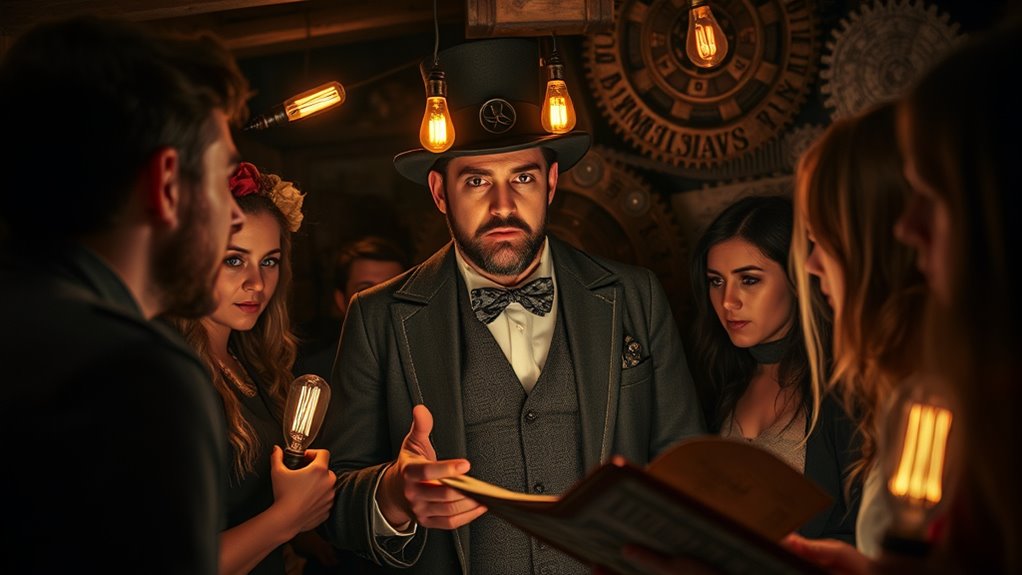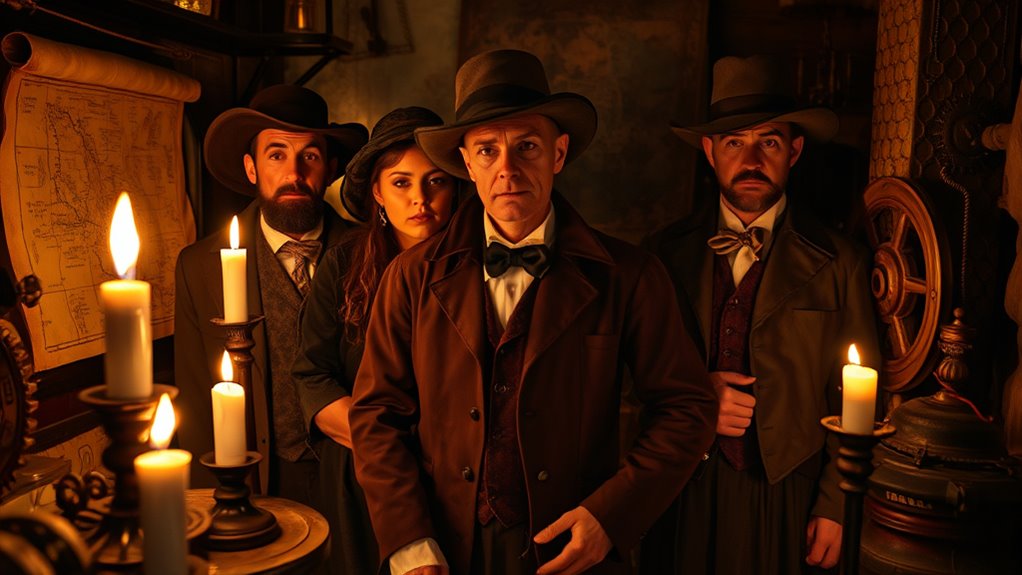Live actors greatly boost your escape room experience by responding in real time and creating a sense of genuine interaction. They serve as storytellers, guides, or obstacles, making the adventure feel more immersive and emotionally engaging. Their presence heightens tension, adds realism, and personalizes the story based on your choices. This human touch transforms puzzles into a compelling narrative, making every moment memorable. Keep exploring to uncover how these elements combine to deepen your immersion even further.
Key Takeaways
- Live actors serve as dynamic storytellers, creating a seamless and engaging narrative flow.
- Their real-time reactions personalize the experience, increasing emotional investment.
- Human interaction heightens realism, making scenarios more visceral and intense.
- Actors evoke emotional responses like fear or excitement, amplifying immersion.
- Their presence transforms static puzzles into an interactive adventure, deepening psychological engagement.

Imagine stepping into an escape room where live actors bring the story to life, transforming a simple puzzle into an immersive adventure. This setup isn’t just about solving riddles; it’s about engaging with a dynamic narrative that reacts to your actions. Live actors serve as storytellers, guides, or even obstacles, creating a seamless flow that heightens your experience through interactive storytelling. As you navigate through the environment, you’ll find yourself not merely solving puzzles but actively participating in a story that unfolds around you. The presence of actors makes every decision more impactful because they respond in real time, adjusting their performances based on your choices. This interaction deepens your psychological engagement, making you feel like a part of the story rather than just an observer. Instead of passively watching a scripted scene, you influence how the story progresses, which keeps your mind sharply focused and emotionally involved.
The live actors’ ability to adapt to your behavior amplifies the realism and intensity of the experience. If you’re hesitant or unsure, an actor might step in to encourage or challenge you, increasing your commitment to the game. Conversely, if you’re confident and quick-thinking, they might shift their approach, pushing you toward new objectives or surprises. This flexibility creates a personalized experience that’s rarely found in traditional escape rooms. You’re not just following preset clues; you’re immersed in a living story that responds to your presence. That responsiveness fuels your psychological engagement, turning a puzzle-solving activity into an emotionally charged adventure. It feels less like working through a checklist and more like living out a narrative where your decisions matter.
Furthermore, live actors can heighten the emotional stakes, making the game more memorable. They can evoke fear, excitement, or curiosity, which amplifies your overall immersion. The realism of interacting with a person, rather than just static props or digital screens, makes the experience more visceral. You feel the tension in their voice, see the urgency in their gestures, and respond instinctively. This interaction creates a layered experience where storytelling and performance blend, making each moment feel genuine and impactful. Incorporating high-quality actors into escape rooms enhances the overall realism and emotional impact, resulting in a more compelling experience. By integrating live actors into escape rooms, designers tap into the power of psychological engagement, transforming simple puzzles into compelling stories that linger long after you leave. It’s this human element that elevates escape room experiences from mere entertainment to truly immersive adventures.
Frequently Asked Questions
How Do Live Actors Adapt to Unexpected Player Actions?
Live actors adapt to unexpected player actions by staying flexible and thinking quickly, ensuring the interactive storytelling remains seamless. They listen carefully, react naturally, and improvise if players take unanticipated routes or make surprising choices. This dynamic interaction boosts audience engagement, making every moment feel authentic and spontaneous. By being adaptable, actors keep the experience exciting and immersive, encouraging players to explore and participate fully in the escape room adventure.
What Training Do Actors Undergo for Escape Room Roles?
You undergo intense training that’s practically legendary, transforming you into the perfect character. This includes mastering character development to convincingly embody your role and understanding costume design to bring authenticity alive. You learn improvisation skills to adapt seamlessly to players’ actions, ensuring the experience remains immersive. Every detail, from your mannerisms to dialogue, is fine-tuned, so you can elevate the escape room’s atmosphere and keep players fully engaged.
How Do Actors Influence the Overall Escape Room Experience?
Actors profoundly influence your escape room experience by bringing thematic storytelling to life, making the environment feel more real and engaging. Their interactive performance keeps you immersed, encouraging deeper audience engagement and emotional investment. By reacting naturally and adapting to your actions, they create a dynamic atmosphere that heightens suspense and excitement, ensuring you stay fully involved in the story and making your escape room adventure unforgettable.
Can Actors Be Scripted or Do They Improvise?
Actors can be both scripted and improvising, depending on the escape room’s design. You might find actors following a detailed script to ensure characterization and story consistency or improvising to adapt to players’ actions, creating a more dynamic experience. Skilled actors balance characterization with script consistency, making interactions feel authentic. This flexibility assists in maintaining the immersion high, allowing players to feel genuinely engaged while still enjoying a cohesive storyline.
What Are the Safety Considerations for Live Actors During Gameplay?
Imagine a delicate dance between thrill and safety, where your live actors perform seamlessly. You must guarantee their safety by implementing strict safety protocols, such as clear communication, emergency exits, and hazard awareness training. Using storytelling techniques, you create immersive yet secure experiences. Regular safety drills and audience management keep everyone safe, so the excitement flows without compromising well-being—making the adventure memorable and secure for all involved.
Conclusion
Bringing live actors into escape rooms remarkably boosts immersion, making the experience more memorable and engaging. Studies show that 78% of players feel more emotionally connected when actors are involved, enhancing teamwork and excitement. By integrating live interactions, you transform a simple puzzle into a compelling story, keeping players on the edge of their seats. So, if you want to elevate your escape room’s impact, incorporating live actors isn’t just an option—it’s the key to creating unforgettable adventures.









